As the first pre-monsoon showers kiss the dry earth and the scent of petrichor rises from the soil, a soft, repetitive call begins to echo across fallow fields and scrublands. This rhythmic “pick-pick-pick” is the voice of the elusive Rain Quail—a small, ground-dwelling bird whose appearance is as fleeting as the rains themselves. Though rarely seen, its call is a sure sign that the monsoon has arrived. 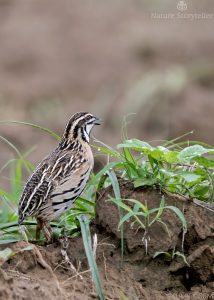 Rain Quails are among India’s most seasonal and secretive birds, perfectly camouflaged in grassy habitats and active mainly during the breeding season. In this article, we explore how to identify this mysterious bird, where to find it, its behaviour, and its role in literature, culture, and ecology.
Rain Quails are among India’s most seasonal and secretive birds, perfectly camouflaged in grassy habitats and active mainly during the breeding season. In this article, we explore how to identify this mysterious bird, where to find it, its behaviour, and its role in literature, culture, and ecology.
Also Read: Indian Peafowl – The Majestic Bird
How to Identify a Rain Quail
The Rain Quail is a small, plump bird, often mistaken for the more commonly seen Common Quail. Identification relies heavily on subtle plumage details and vocal cues.
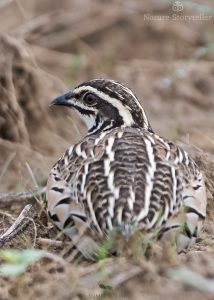
Key Identification Features:
- Size: ~18 cm; compact and round-bodied.
- Plumage: Sandy brown upperparts mottled with black and buff streaks—excellent camouflage in dry grasslands.
- Throat and Face:
- Male: Has a distinct black throat patch bordered by white—a key distinguishing feature.
- Female: Lacks black markings; more uniformly buff with lighter streaks.
- Breast and Flanks: Pale with fine black streaking.
- Call: A repetitive “pick-pick-pick”, especially active during early mornings and late evenings in the monsoon.
Rain Quails often freeze or scurry instead of flying when approached, making them incredibly hard to spot despite being vocally conspicuous.
Habitat and Distribution of Rain Quails
Preferred Habitat:
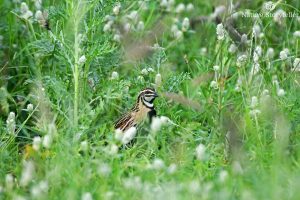
Rain Quails thrive in:
- Dry grasslands
- Open scrublands
- Cultivated fields with scattered cover
- Edges of wetlands and fallow lands
They prefer areas with low vegetation that provide both camouflage and foraging opportunities.
Geographic Range:
- India: Widely distributed across the Indian subcontinent, from Punjab and Rajasthan in the west to West Bengal and Assam in the east, and southward into central and peninsular India.
- Also found in Bangladesh, Nepal, Pakistan, and parts of Southeast Asia.
They are notably scarce or absent in dense forests and high-altitude regions.
Suggested Read: Indian Paradise Flycatcher
Where and When to Find Rain Quails
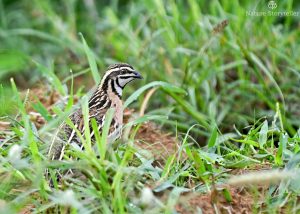
- Best Time: Just before and during the southwest monsoon (June–September).
- Where to Look:
- Agricultural fields post-harvest.
- Grasslands in protected areas (e.g., Velavadar National Park, Naliya Grasslands).
- Scrub-fringed wetland areas.
Often heard more than seen, listening for their call at dawn or dusk is the best strategy. With patience, observers may glimpse them darting through the undergrowth or dust-bathing near trails.
Also Read: Indian Pitta – The Summer Migrant to North India
Migration Pattern in Rain Quails
Rain Quails are partially migratory and seasonal movers within the Indian subcontinent.
- In northern and western India, they are largely summer and monsoon visitors, arriving with the first rains.
- In southern India, they may be more resident, though populations fluctuate seasonally.
- Their appearance often coincides with the onset of monsoon—hence their name.
Unlike long-distance migratory quails, Rain Quails tend to move locally and opportunistically, tracking rain patterns and food availability.
Diet and Behaviour of Rain Quails
Rain Quails are omnivores, with a diet that varies seasonally:
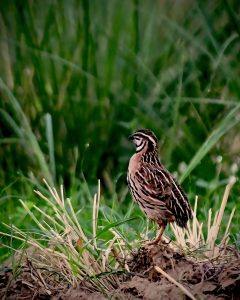
Diet:
- Seeds of grasses and grains (millet, sorghum, etc.)
- Insects such as ants, beetles, grasshoppers
- Small invertebrates and green shoots during the breeding season
Behaviour:
- Ground-dwelling and highly secretive
- Walk or run rather than fly unless startled
- Nest on the ground in shallow scrapes lined with grass
- Breeding triggered by rains; males become more vocal and territorial
Both parents may take part in caring for the young, who are precocial and begin foraging soon after hatching.
Conservation Status of Rain Quails
- IUCN Red List: Least Concern
- Population Trend: Appears stable, but under-surveyed due to elusive nature
Threats:
- Habitat loss from intensive agriculture and grassland degradation
- Pesticide use, affecting insect prey
- Unregulated hunting in some regions
Grassland conservation efforts indirectly benefit Rain Quail populations, but more focused studies are needed to fully assess their population trends.
Must Read: Common Hawk-Cuckoo
Rain Quails in Literature and Mythology
Though not as prominently featured as the koel or partridge in Indian literature, the Rain Quail makes subtle appearances in vernacular proverbs and folk songs.
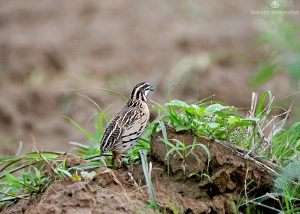
In Culture:
- In parts of Rajasthan and Gujarat, the Rain Quail’s call is believed to herald good rains and fertility of crops.
- In rural songs, its vocalizations are mimicked as a metaphor for the arrival of lovers or long-lost kin, coinciding with the monsoon’s homecoming theme.
In Folklore:
- In Bhojpuri and Bundeli folk tales, its voice is sometimes considered a summoning call for clouds, much like the peacock’s dance.
While it does not hold divine status in mythology, its symbolic presence in seasonal lore reflects the intimate link between avian cues and agrarian life in India.
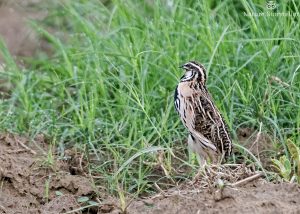
Similarities and Differences among Quails
Rain Quails are often confused with the Common Quail (Coturnix Coturnix) and Jungle Bush Quail (Perdicula Asiatica).
|
Feature |
Rain Quail | Common Quail |
Jungle Bush Quail |
| Call | “Pick-pick-pick” | Whistled “whit-whit” | Rolling “prr-r-prr-r” |
| Throat Marking | Male has black patch | No throat patch | Variable |
| Size | Smaller (~18 cm) | Slightly larger (~19–20 cm) | More compact, darker plumage |
| Habitat | Open grasslands | Farmlands, fields | Dry scrub, forest edge |
| Behaviour | Migratory | Migratory | Resident |
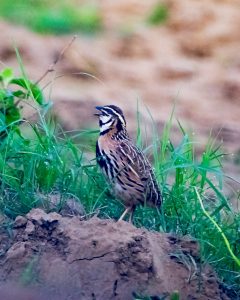
The Rain Quail is a bird of monsoon whispers and grassy camouflage. Often unheard-of until its soft call pierces the pre-rain stillness, it embodies the seasonal pulse of India’s grasslands and agricultural landscapes. As more habitats are lost and natural cycles disrupted, the Rain Quail’s voice becomes not just a welcome note of the rains—but a reminder of what is fragile, seasonal, and deeply connected to the rhythm of the land.
